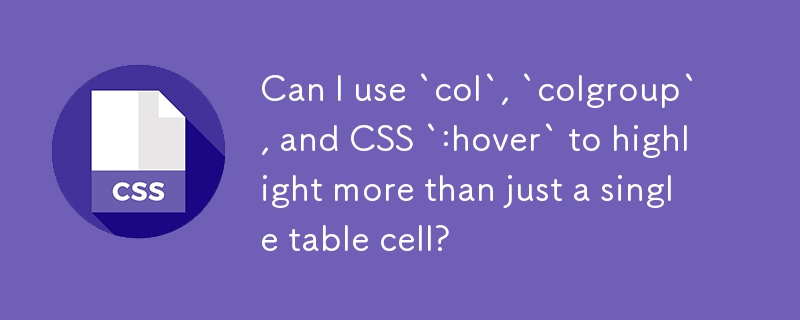 Web Front-end
Web Front-end
 CSS Tutorial
CSS Tutorial
 Can I use `col`, `colgroup`, and CSS `:hover` to highlight more than just a single table cell?
Can I use `col`, `colgroup`, and CSS `:hover` to highlight more than just a single table cell?
Can I use `col`, `colgroup`, and CSS `:hover` to highlight more than just a single table cell?
Nov 08, 2024 am 07:35 AM
Can col, colgroups and the css "hover" pseudoclass be used for more than just a single cell?
To highlight table rows and columns on mouse hover, CSS pseudo-classes like ":hover" can be used. But what if you want to highlight not just a single cell, but an entire row or column, including the headers?
A pure CSS solution can achieve this using the ::before and ::after pseudo-elements. These elements add content before and after the selected element, respectively. Here's how:
-
Create Highlight Elements:
- Add ::before for row highlighting and ::after for column highlighting after the relevant elements (e.g., tr, td, th).
- Use absolute positioning to allow these elements to extend anywhere.
- Position them outside the element's bounds using negative values for left/top (::before) or left/bottom (::after).
- Set a larger width/height to cover the entire row/column.
-
Hide Highlight Overflow:
- Prevent the highlight elements from overflowing the table by setting overflow: hidden on the table.
- This keeps the table area clean while ensuring the highlight extends beyond individual cells.
-
Add Row/Column Selectors:
- To highlight only the current row or column, use the ::before and ::after elements on :hover th (headers) and :hover .row / .col (class-based selectors for rows/columns).
The CSS code below implements these principles:
table { overflow: hidden; }
td, th, .row, .col { cursor: pointer; padding: 10px; position: relative; }
td:hover::before, .row:hover::before { background-color: #FFA; content: '<pre class="brush:php;toolbar:false"><table>
<tr>
<th></th><th>50kg</th><th>55kg</th><th>60kg</th><th>65kg</th><th>70kg</th>
</tr>
<tr class="row">
<th class="row">160cm</th><td>20</td><td>21</td><td>23</td><td>25</td><td>27</td>
</tr>
<tr class="row">
<th class="row">165cm</th><td>18</td><td>20</td><td>22</td><td>24</td><td>26</td>
</tr>
</table>a0'; height: 100%; left: -5000px; position: absolute; top: 0; width: 10000px; z-index: -1; }
td:hover::after, .col:hover::after { background-color: #FFA; content: 'a0'; height: 10000px; left: 0; position: absolute; top: -5000px; width: 100%; z-index: -1; }
The HTML remains largely unchanged, but includes class names for rows and columns:
This solution works in modern browsers, extending the hover highlight effect to entire rows and columns elegantly.
The above is the detailed content of Can I use `col`, `colgroup`, and CSS `:hover` to highlight more than just a single table cell?. For more information, please follow other related articles on the PHP Chinese website!

Hot AI Tools

Undress AI Tool
Undress images for free

Undresser.AI Undress
AI-powered app for creating realistic nude photos

AI Clothes Remover
Online AI tool for removing clothes from photos.

Clothoff.io
AI clothes remover

Video Face Swap
Swap faces in any video effortlessly with our completely free AI face swap tool!

Hot Article

Hot Tools

Notepad++7.3.1
Easy-to-use and free code editor

SublimeText3 Chinese version
Chinese version, very easy to use

Zend Studio 13.0.1
Powerful PHP integrated development environment

Dreamweaver CS6
Visual web development tools

SublimeText3 Mac version
God-level code editing software (SublimeText3)

Hot Topics
 What is 'render-blocking CSS'?
Jun 24, 2025 am 12:42 AM
What is 'render-blocking CSS'?
Jun 24, 2025 am 12:42 AM
CSS blocks page rendering because browsers view inline and external CSS as key resources by default, especially with imported stylesheets, header large amounts of inline CSS, and unoptimized media query styles. 1. Extract critical CSS and embed it into HTML; 2. Delay loading non-critical CSS through JavaScript; 3. Use media attributes to optimize loading such as print styles; 4. Compress and merge CSS to reduce requests. It is recommended to use tools to extract key CSS, combine rel="preload" asynchronous loading, and use media delayed loading reasonably to avoid excessive splitting and complex script control.
 External vs. Internal CSS: What's the Best Approach?
Jun 20, 2025 am 12:45 AM
External vs. Internal CSS: What's the Best Approach?
Jun 20, 2025 am 12:45 AM
ThebestapproachforCSSdependsontheproject'sspecificneeds.Forlargerprojects,externalCSSisbetterduetomaintainabilityandreusability;forsmallerprojectsorsingle-pageapplications,internalCSSmightbemoresuitable.It'scrucialtobalanceprojectsize,performanceneed
 Does my CSS must be on lower case?
Jun 19, 2025 am 12:29 AM
Does my CSS must be on lower case?
Jun 19, 2025 am 12:29 AM
No,CSSdoesnothavetobeinlowercase.However,usinglowercaseisrecommendedfor:1)Consistencyandreadability,2)Avoidingerrorsinrelatedtechnologies,3)Potentialperformancebenefits,and4)Improvedcollaborationwithinteams.
 CSS Case Sensitivity: Understanding What Matters
Jun 20, 2025 am 12:09 AM
CSS Case Sensitivity: Understanding What Matters
Jun 20, 2025 am 12:09 AM
CSSismostlycase-insensitive,butURLsandfontfamilynamesarecase-sensitive.1)Propertiesandvalueslikecolor:red;arenotcase-sensitive.2)URLsmustmatchtheserver'scase,e.g.,/images/Logo.png.3)Fontfamilynameslike'OpenSans'mustbeexact.
 What is Autoprefixer and how does it work?
Jul 02, 2025 am 01:15 AM
What is Autoprefixer and how does it work?
Jul 02, 2025 am 01:15 AM
Autoprefixer is a tool that automatically adds vendor prefixes to CSS attributes based on the target browser scope. 1. It solves the problem of manually maintaining prefixes with errors; 2. Work through the PostCSS plug-in form, parse CSS, analyze attributes that need to be prefixed, and generate code according to configuration; 3. The usage steps include installing plug-ins, setting browserslist, and enabling them in the build process; 4. Notes include not manually adding prefixes, keeping configuration updates, prefixes not all attributes, and it is recommended to use them with the preprocessor.
 What are CSS counters?
Jun 19, 2025 am 12:34 AM
What are CSS counters?
Jun 19, 2025 am 12:34 AM
CSScounterscanautomaticallynumbersectionsandlists.1)Usecounter-resettoinitialize,counter-incrementtoincrease,andcounter()orcounters()todisplayvalues.2)CombinewithJavaScriptfordynamiccontenttoensureaccurateupdates.
 CSS: When Does Case Matter (and When Doesn't)?
Jun 19, 2025 am 12:27 AM
CSS: When Does Case Matter (and When Doesn't)?
Jun 19, 2025 am 12:27 AM
In CSS, selector and attribute names are case-sensitive, while values, named colors, URLs, and custom attributes are case-sensitive. 1. The selector and attribute names are case-insensitive, such as background-color and background-Color are the same. 2. The hexadecimal color in the value is case-sensitive, but the named color is case-sensitive, such as red and Red is invalid. 3. URLs are case sensitive and may cause file loading problems. 4. Custom properties (variables) are case sensitive, and you need to pay attention to the consistency of case when using them.
 What is the conic-gradient() function?
Jul 01, 2025 am 01:16 AM
What is the conic-gradient() function?
Jul 01, 2025 am 01:16 AM
Theconic-gradient()functioninCSScreatescirculargradientsthatrotatecolorstopsaroundacentralpoint.1.Itisidealforpiecharts,progressindicators,colorwheels,anddecorativebackgrounds.2.Itworksbydefiningcolorstopsatspecificangles,optionallystartingfromadefin





